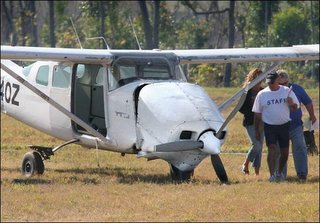Given that there was still substantial fuel in the left tank, which was the one selected, this doesn't appear to be a case of fuel starvation. Perhaps there was some debris in the fuel line? Once again, it'll be interesting to see what NTSB comes up with.NTSB Identification: MIA06LA037
14 CFR Part 91: General Aviation
Accident occurred Thursday, December 29, 2005 in Lake Wales, FL
Aircraft: Cessna P206C, registration: N8640Z
Injuries: 4 Uninjured.
This is preliminary information, subject to change, and may contain errors. Any errors in this report will be corrected when the final report has been completed.
On December 29, 2005, about 1145 eastern standard time, a Cessna P206C, N8640Z, registered to Fayard Enterprises, Inc., operated by Florida Skydiving Center, experienced a total loss of engine power shortly after takeoff from Lake Wales Municipal Airport, Lake Wales, Florida. Visual meteorological conditions prevailed at the time and no flight plan was filed for the 14 CFR Part 91, local, skydiving flight from Lake Wales Municipal Airport. The airplane was substantially damaged and the commercial-rated pilot, and 3 skydivers were not injured. The flight was originating at the time of the occurrence.
The pilot stated that on the day of the accident he started his day between 0800 and 0830, and before the first flight added 30 gallons of fuel to each fuel tank. The flight departed with the 1st load of skydivers with the fuel selector positioned to the right tank. He flew 10 "loads"; each "load" was flown to 4,000 feet. After landing following the 10th load he moved the fuel selector to the left tank position, and flew 2 "loads" also to 4,000 feet. He landed, loaded skydivers for his 13th load, and departed. During climbout at 400 feet, the engine quit suddenly. There was no sputtering. He immediately pumped the throttle 2 times, and turned on the auxiliary fuel pump which did not restore engine power. He did not have time to look at the fuel pressure gauge or check the magnetos, and set up for a forced landing in an industrial park near the airport. He maneuvered the airplane for a forced landing, touched down, and rolled approximately 250 feet before coming to rest.
Postaccident examination of the airplane by an FAA airworthiness inspector revealed the left fuel tank contained approximately 20 gallons, and the right fuel tank approximately 7 gallons. No fuel contamination was noted.
The picture from the local newspaper makes clear that an engine tear down will be in order:

No comments:
Post a Comment